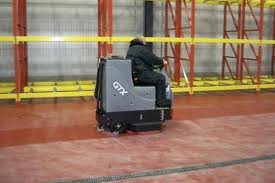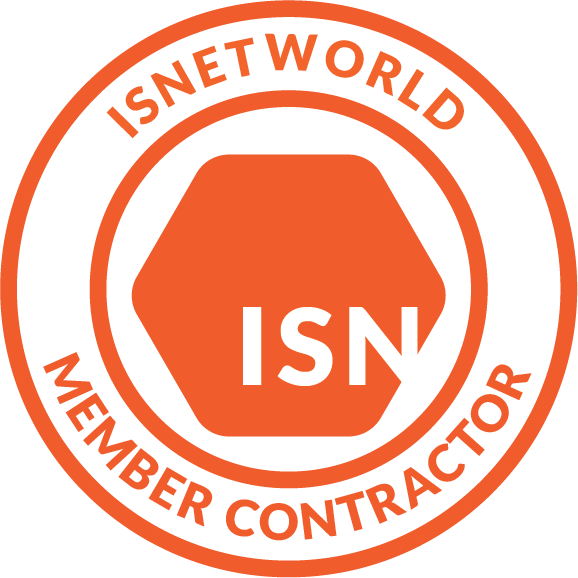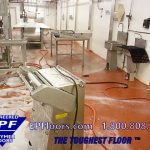Cleaning Guide | How to clean Epoxy floor coatings
After installing epoxy flooring or urethane flooring, it is important to start a routine maintenance program. Cleaning Epoxy floor coatings on a regular basis, will ensure that the floor retains its original finish as long as possible. This shall protect your investment, and ensure that your floor looks it best for years to come!
 OVERVIEW – WHY CLEAN YOUR EPOXY FLOOR COATING?
OVERVIEW – WHY CLEAN YOUR EPOXY FLOOR COATING?
Appearance: Your floor will look its best when it is clean. By installing a polymeric floor in your facility, you are telling people that you care about your image. By instituting a scheduled cleaning program, the floor will continue to look and perform as it did when it was first installed.
Safety: No matter how aggressive the texture of your floor, if it is not cleaned properly, it can present a slip hazard. Emulsifying, rinsing and drying your floor properly will reduce the risk of a slip and fall incident.
Service Life: The lifetime of your floor will be extended with proper cleaning. In aggressive use areas, contaminants such as oil, dirt and grease work with water and bacteria to attack your floor. This can lead to damage of the floor.
Care of Brand New Floor Coatings
CURING TIME:
Full cure for epoxy and polyurethane floors is 72 hours at 68 degree F. Avoid chemical spills and full traffic during cure period. Premature exposure may cause permanent staining or discoloration. Do Not use abrasive cleaning methods during the first week after installation.
TEMPORARY NEW FLOOR PROTECTION
If any heavy rigging for replacement of equipment,is to be performed on the new flooring, care must be taken to protect the new flooring. Plywood, 3/16” hardboard ($.50/sf), Ram Board (Home Depot- $.18/sf) or any other heavy duty surface shall provide good protection. To protect against general construction traffic, thick plastic sheeting with builders paper over top, with taped seams, should be suitable.
WHEN TO CLEAN YOUR EPOXY FLOOR COATING
When brand new, one should begin cleaning floor coatings within a few days after installation, with a mild detergent. EP Floors systems are designed to be used in traffic areas that typically accumulate foreign matter. Because of this, the recommended maintenance schedule for most areas is once or twice daily cleaning and regular “touch-ups” for spills. Less frequent cleaning of these areas results in a buildup of foreign matter, which diminishes the Appearance, Safety and Service Life of the floor.
CLEANERS
A mild cleaner such as Simple Green or Spic and Span are suitable for most cleaning.We do not recommend citrus based cleaners, as they may remove the gloss.
CLEANING PROCESS
When cleaning floor coatings applied by EPF, please use a good cleaning product and follow a six step process.
The six steps are:
- Sweeping – always sweep the floor thoroughly before cleaning.
- Application – Apply the cleaning product to the floor surface.
- Dwell Time – Let the cleaning product stand on the surface to allow time to emulsify foreign material.
- Agitation – Movement of the cleaning product with a piece of equipment on the floor surface to aid in the release of foreign material. A walk behind or riding automatic floor scrubber machine is usually cost effective for large areas.
- Removal – Removing the cleaning product from the surface.
- Rinsing – Rinsing the floor with clean water and removing the rinse water from the floor.
- Never use a mop to clean a floor that is greasy or oily.
- Make sure the brushes on the automatic scrubber are in good shape. Brushes should be nylon non-abrasive medium flex bristle brush.
- When using a deck brush, choose a medium/stiff bristle.
- When removing solution with a squeegee, use a soft, neoprene squeegee. Do Not use a water spray to remove cleaning solution from the floor because it will over-dilute the solution and cause grease and oil to fall back onto the floor.
SCRATCHES AND GOUGES
Heavy machinery, pallets or sharp objects should not be slid or scraped along the floor. This can results in cuts gouges.
STAINS
Should staining occur, attempt removal first with a mild solution, progressing to stronger cleaners until the stain disappears. It is always a good idea to wear eye protection when working with chemicals. Residue from a spill that has dried can be removed with a plastic tool (take care not to scratch the surface). Then use a mild detergent to remove the stain.
PLASTICIZERS MARKS
Plasticizer marks, which are sometimes referred to as shadows, are permanent marks left in floor coatings. These marks are caused by chemicals called plasticizers that are used in the manufacturing of rubber wheels. After the wheels are in contact with the floor for a period of time, the plasticizers can seep into the floor coating, leaving dark spots on the floor. While these marks cannot be removed, they can be hidden by sanding and recoating the floor. The best method of preventing the problem of plasticizer marks is to prevent them in the first place….if possible, use non-marking “often white in color” tires on material handling equipment, if at all possible.
RECOATING
After a number of years, a re-application of the topcoat will restore the finish to new like condition.
With proper maintenance, your new EPF system should provide many years of useful service life.
Why Wax an Epoxy Floor?
With EPF’s systems, waxing is NOT necessary. However, to maintain the highest gloss and aesthetics possible for epoxy or polyurethane top coated floors, they may be waxed using the procedures below:
STEP ONE:
Remove old wax and ground in dirt, using floor stripping liquid. Products are available which rapidly dissolve multiple layers of floor wax finish, allowing in some applications for removal, without the use of floor machines or stripping pads.
STEP TWO:
Wax the Floor
STEP THREE:
Routine maintenance (to be expected with any floor) is all that is required to maintain the luster and conductivity of the finish. Once a week, wet mop the floor with a diluted mixture of floor cleaner and water and allow to dry. Power scrubbing equipment w/ soft nylon bristle pads OR hand mopping is recommended.
STEP FOUR:
Mirror Like Shine. Buff dry using a spray-buff pad on your floor polishing machine.
Cleaning Anti Statics Floors
Anti Static Flooring – Cleaning Floor Coatings
- Dust Mop Daily (It’s important to remove abrasives that can scratch and degrade the conductivity by dry mopping).
- Once a week, wet mop the floor with a diluted mixture of alkaline (non-residue) floor cleaner and water and allow to dry.
- Auto Scrub every 2 weeks, or as needed (with a diluted mixture of alkaline non-residue floor cleaner) to remove ground in dirt and contaminants. Use soft nylon bristle pads (or red buffer pads). In most cases aggressive scuff marks can be removed via auto scrubbing. If necessary, apply detergent and allow to soak in, to release ground-in scuff marks, then scrub. (note: blue or more aggressive pads may reduce gloss in the floor)
Many cleaners and detergents leave behind harmful insulative residues reducing the conductivity of the ESD floor finish. Ensure that the product you are using shall not leave any residue on the floor.
Clients receive years worth of service from the initial installation (and routine maintenance) of the EPF system. After 10 or more years, severe scuff marks and ground in detritus may begin to take a toll on the gloss and aesthetics. At this time, flooring may be re-coated, at a nominal cost.
OPTIONAL ESD Floor Waxing
Always use new mops, one for the ESD floor wax stripper, one for the esd floor cleaner, and one for the application of the esd wax.
Use the proper mops for a specific application. Example: Non-linting rayon loop end finish mops.
Additional cleaning floor coatings tips.



